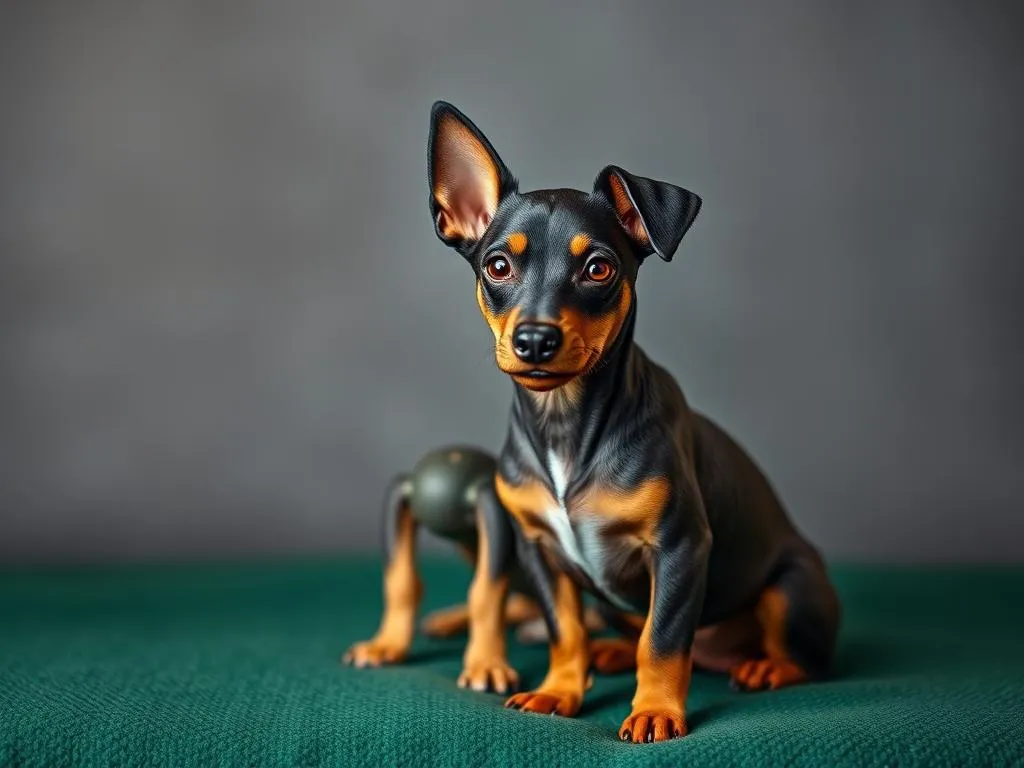
Miniature Pinscher mixes are a delightful combination of the spirited Miniature Pinscher and other dog breeds, resulting in unique companions with diverse characteristics. Understanding these mixes not only helps potential dog owners make informed choices but also deepens appreciation for the Miniature Pinscher itself. This article delves into the world of miniature pinscher mixes, exploring their traits, care, and more.
What Are Miniature Pinscher Mixes?
Definition of a Mixed Breed
A mixed breed dog, often referred to as a mutt, is simply a canine that has ancestry from two or more different breeds. Contrary to some misconceptions, mixed breeds are not inherently inferior or less desirable than purebreds. In fact, they often benefit from a broader genetic pool, which can lead to improved health and temperament. Miniature Pinscher mixes are particularly popular, combining the charming qualities of the Miniature Pinscher with those of various other breeds.
Characteristics of Miniature Pinscher Mixes
Miniature Pinscher mixes vary widely in size, weight, and physical traits, depending on the other breed involved. However, they typically inherit the Miniature Pinscher’s sleek, muscular build and striking features. Most weigh between 10 to 25 pounds and stand 10 to 18 inches tall.
Temperament-wise, these mixes often showcase the Min Pin’s lively, confident, and playful personality. They tend to be affectionate with their families but can be wary of strangers, making them excellent watchdogs. Common health concerns include patellar luxation, hip dysplasia, and heart problems. Regular vet visits and a healthy diet are essential for maintaining their well-being.
Popular Miniature Pinscher Mixes
Overview of Popular Mixes
Miniature Pinscher mixes have gained popularity due to their diverse traits and charming personalities. Here’s a list of some common mixes:
- Doxie-Pin (Min Pin Dachshund Mix)
- Chihuahua-Pin (Min Pin Chihuahua Mix)
- Beagle-Pin (Min Pin Beagle Mix)
- Poodle-Pin (Min Pin Poodle Mix)
Each combination brings its own unique characteristics to the table, making them appealing for different lifestyles and preferences.
Detailed Profiles of Selected Miniature Pinscher Mixes
Doxie-Pin
The Doxie-Pin, or Min Pin Dachshund mix, combines the exuberance of the Miniature Pinscher with the laid-back nature of the Dachshund. This mix is typically small, weighing around 10 to 20 pounds.
Characteristics and Temperament: Doxie-Pins are known for their playful and affectionate demeanor. They enjoy cuddling with their families but also have bursts of energy that require regular playtime.
Pros and Cons: This mix is relatively easy to train, but they can inherit stubbornness from the Dachshund side. They may also be prone to bark, especially if they sense a stranger nearby.
Ideal Living Conditions: Doxie-Pins thrive in various environments, from apartments to houses with yards, as long as they receive daily exercise.
Chihuahua-Pin
The Chihuahua-Pin, or Min Pin Chihuahua mix, is a tiny dog with a big personality. Weighing only 5 to 15 pounds, this mix is perfect for those who prefer smaller dogs.
Characteristics and Temperament: Known for their feisty nature, Chihuahua-Pins are affectionate and loyal companions. They can be protective of their owners, making them excellent watchdogs.
Pros and Cons: Their small size makes them suitable for apartment living, but they may require socialization to reduce any aggressive tendencies towards other dogs.
Ideal Living Conditions: These mixes are best suited for smaller living spaces, as long as they have opportunities for walks and playtime.
Beagle-Pin
The Beagle-Pin, or Min Pin Beagle mix, is a medium-sized dog that typically weighs between 15 to 25 pounds. This mix combines the playful nature of the Min Pin with the gentle, friendly demeanor of the Beagle.
Characteristics and Temperament: Beagle-Pins are affectionate and excellent with families, often getting along well with children. They are curious and love to explore, which can sometimes lead to mischief.
Pros and Cons: While they are typically easy to train, their Beagle lineage may make them prone to distractions, especially if they catch a scent.
Ideal Living Conditions: This mix benefits from a home with a fenced yard where they can safely explore and play.
Poodle-Pin
The Poodle-Pin, or Min Pin Poodle mix, is a delightful blend of energy and intelligence. Depending on whether the Poodle is a standard or miniature, this mix can vary in size, usually between 10 to 20 pounds.
Characteristics and Temperament: Poodle-Pins are known for their intelligence and eagerness to please, making training relatively easy. They are playful, affectionate, and good with families.
Pros and Cons: Their Poodle heritage may give them a hypoallergenic coat, which is a plus for allergy sufferers. However, they require regular grooming to keep their fur in good condition.
Ideal Living Conditions: Poodle-Pins adapt well to various living situations but need regular exercise and mental stimulation to stay happy.
Care and Training for Miniature Pinscher Mixes
Basic Care Requirements
Proper care is crucial for the health and happiness of miniature pinscher mixes.
Diet and Nutrition: A balanced diet tailored to their size and activity level is essential. High-quality dog food with a good balance of protein, fats, and carbohydrates will help maintain their energy levels and overall health.
Grooming Needs: Grooming requirements vary based on the mix. Short-haired mixes may require minimal grooming, while those with longer fur, like the Poodle-Pin, will need regular brushing to prevent matting.
Exercise and Activity Levels: Most miniature pinscher mixes are active and require daily exercise. Regular walks, play sessions, and mental stimulation through toys or training exercises are essential to keep them physically and mentally fit.
Training and Socialization
Training and socialization are vital in ensuring a well-adjusted dog.
Importance of Early Socialization: Exposing your miniature pinscher mix to various environments, people, and animals during their early developmental stages can help prevent behavioral issues later in life.
Effective Training Methods: Positive reinforcement techniques, such as treats and praise, are highly effective for training these intelligent dogs. Consistency and patience are crucial, as some mixes can inherit stubbornness.
Common Behavioral Issues and Solutions: Some miniature pinscher mixes may exhibit barking, digging, or separation anxiety. Addressing these behaviors through training and providing plenty of mental and physical stimulation can help mitigate these issues.
Health Considerations for Miniature Pinscher Mixes
Common Health Problems
Understanding potential health issues is essential for any dog owner. Miniature pinscher mixes can inherit genetic predispositions from their parent breeds, leading to various health concerns:
- Patellar Luxation: Common in small breeds, this condition occurs when the kneecap dislocates, causing pain and mobility issues.
- Hip Dysplasia: A hereditary condition affecting the hip joint, leading to arthritis and discomfort.
- Heart Problems: Certain breeds, including the Miniature Pinscher, may be prone to heart diseases.
Regular vet check-ups, a balanced diet, and a healthy lifestyle can help mitigate these risks.
Lifespan and Aging
The average lifespan of miniature pinscher mixes ranges from 12 to 16 years, depending on their overall health and genetics.
Tips for Caring for Aging Dogs: As your dog ages, they may require more frequent vet visits, specialized diets, and adjustments to their exercise routine. Providing a comfortable environment and maintaining their mental engagement is essential for their well-being.
Adoption and Finding a Miniature Pinscher Mix
Where to Adopt
When considering a miniature pinscher mix, prospective owners can explore various avenues:
- Reputable Breeders: Look for breeders who prioritize health testing and responsible breeding practices.
- Shelters and Rescues: Many wonderful mixed-breed dogs are in need of homes. Shelters often have a variety of miniature pinscher mixes available for adoption.
Questions to Ask When Adopting a Mixed Breed Dog: Inquire about the dog’s health history, temperament, and any known behavioral issues. Understanding the dog’s background can help ensure a good match for your lifestyle.
Preparing for Your New Dog
Bringing a new dog home requires preparation.
Essential Supplies and Setup: Gather necessary supplies, including food and water bowls, a comfortable bed, toys, and grooming tools. Creating a designated space for your new pet will help them acclimate to their new environment.
Transition Tips for the New Pet Owner: Give your new dog time to adjust to their new surroundings. Establishing a routine for feeding, walks, and playtime will help them feel secure and settle in more quickly.
Conclusion
Owning a miniature pinscher mix can bring joy and companionship into your life. These mixes offer unique traits that can suit various lifestyles, making them wonderful pets for many families. With the right care, training, and understanding of their needs, these dogs can thrive as beloved family members. Whether you choose to adopt or purchase a miniature pinscher mix, responsible ownership and care will ensure a rewarding relationship for years to come.









